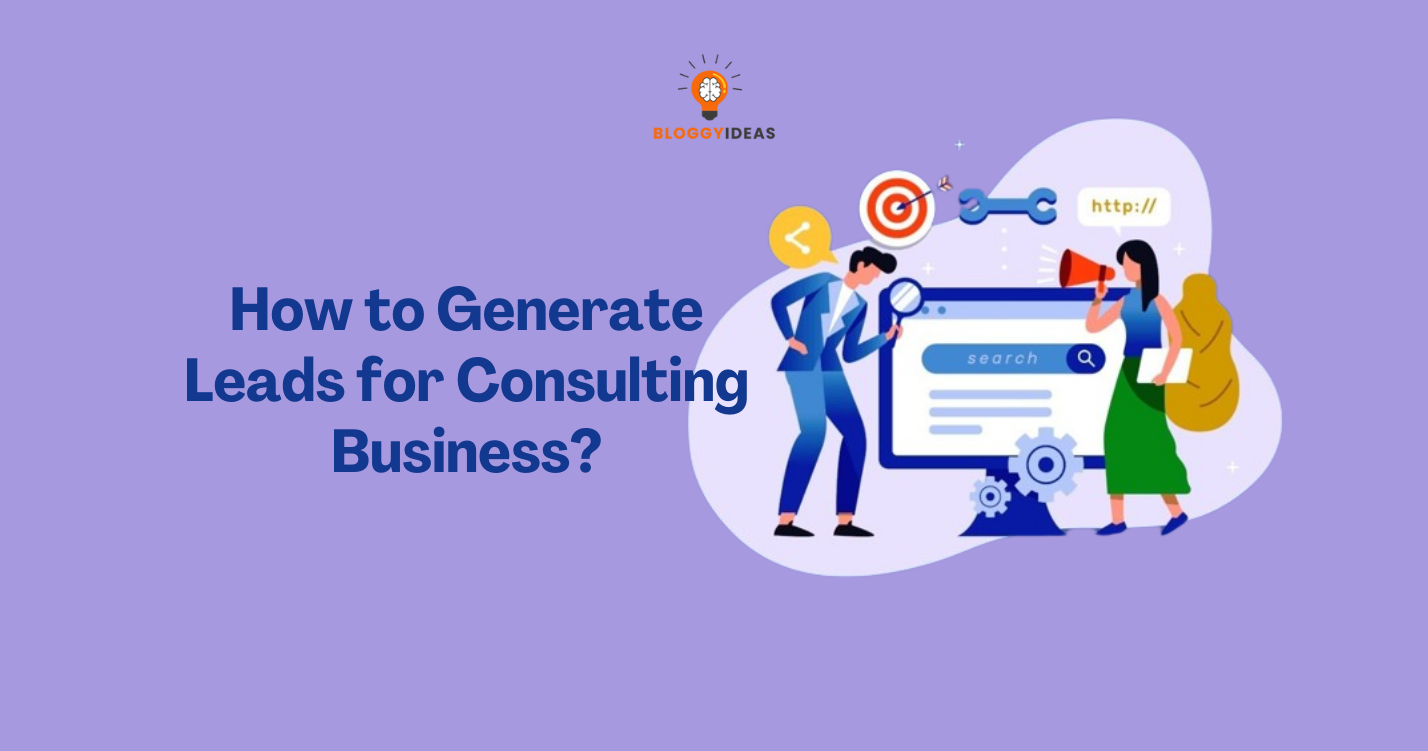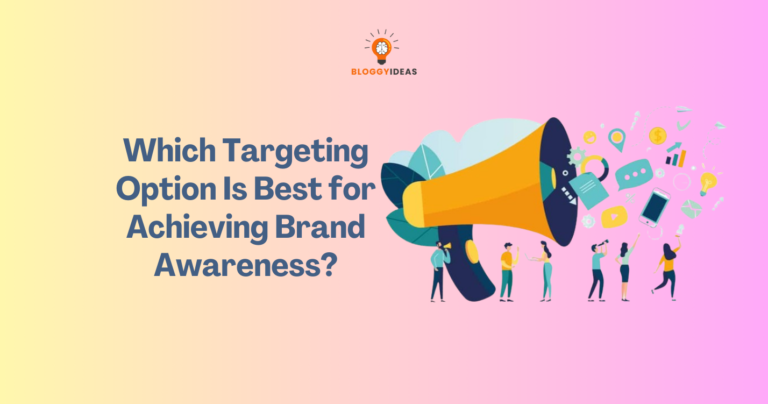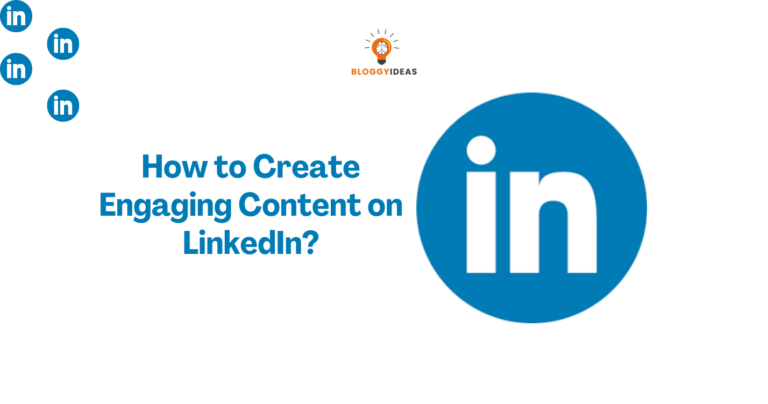How to Generate Leads for Consulting Business?
“Quick Overview” Generating leads is a vital aspect of running a successful consulting business. Without a consistent flow of potential clients, it can be challenging to sustain and grow your consultancy. In this blog, we will explore effective strategies for lead generation that can help you attract and convert valuable prospects.
From defining your target audience to optimizing your online presence, implementing content marketing tactics, and nurturing leads through follow-up, we’ll cover a range of techniques to help you generate leads and take your consulting business to new heights. So, let’s dive in and discover how to unleash the power of lead generation for your consulting business.
Define Your Target Audience
Identifying Your Target Audience for Lead Generation
When it comes to lead generation, understanding your target audience is crucial. Identifying your ideal clients allows you to tailor your marketing efforts, messaging, and services to resonate with their specific needs and preferences. By focusing on a defined target audience, you can maximize your efforts and attract higher-quality leads who are more likely to convert into paying clients.
Understand Your Audience’s Needs and Preferences
One effective way to understand your target audience is by creating buyer personas. Buyer personas are fictional representations of your ideal clients, based on real data and insights. These personas encapsulate the characteristics, behaviors, motivations, and goals of your target audience, allowing you to better connect with them.
To create buyer personas, follow these steps:
- Collect Data: Gather information about your existing clients, conduct surveys, and interview them to understand their pain points, challenges, and aspirations. Use analytics tools to gain insights into their demographics, online behavior, and preferences.
- Identify Common Traits: Look for patterns and similarities among your clients. Group them based on demographics, industry, job title, company size, or any other relevant factors.
- Dive Deeper: Once you’ve identified common traits, delve deeper into their motivations, goals, and challenges. Consider their decision-making process, preferred communication channels, and any specific preferences they might have.
- Develop Personas: Create detailed profiles for each persona, giving them a name, age, job title, and a brief backstory. Include information about their goals, pain points, preferred solutions, and objections.
By developing buyer personas, you can humanize your target audience and gain a deeper understanding of their needs. This insight will enable you to tailor your messaging and marketing efforts more effectively.
Market Research
Market research is a valuable tool for gathering insights about your target audience. Here are some tips to conduct effective market research:
- Surveys and Interviews: Design and distribute surveys to your existing clients, prospects, and target audience. Conduct interviews to gather qualitative insights. Ask questions about their needs, preferences, challenges, and expectations.
- Competitor Analysis: Study your competitors to understand their target audience. Analyze their marketing strategies, messaging, and positioning to gain insights into their customer base.
- Social Media Listening: Monitor social media platforms to gather feedback, opinions, and discussions related to your industry and target audience. Identify trends, pain points, and topics of interest.
- Online Analytics: Utilize website analytics tools to gather data about your website visitors. Understand their demographics, behavior, and interactions with your content. Identify patterns and trends that can help refine your targeting.
- Online Communities and Forums: Join relevant online communities and forums where your target audience congregates. Observe conversations, participate in discussions, and gain insights into their needs and challenges.
- Data Analysis: Analyze existing customer data, sales records, and customer support interactions to identify common trends and patterns. This information can help you understand your target audience’s preferences and pain points.
Develop a Strong Online Presence
Importance of a Professional Website for Lead Generation
Having a professional website is crucial for generating leads for your consulting business. It serves as the online face of your company and is often the first impression potential clients have of your services.
A well-designed website can instill trust and credibility, making visitors more likely to engage with your content and contact you for further information. Ensure that your website is user-friendly, visually appealing, and reflects your brand identity.
Clearly communicate your services, expertise, and unique value proposition to attract the right audience.
SEO to Improve Online Visibility
Search engine optimization (SEO) plays a vital role in enhancing your online visibility and driving organic traffic to your website. By optimizing your website for relevant keywords, you increase the chances of appearing in search engine results when potential clients are actively looking for consulting services.
Conduct keyword research to identify the terms and phrases your target audience is likely to use, and incorporate them strategically into your website’s content, meta tags, and headings.
Additionally, focus on creating high-quality and informative content that aligns with your target audience’s interests and needs, as search engines prioritize valuable content.
Benefits of Creating Valuable Content Through a Blog
Creating valuable content through a blog or resources section on your website serves multiple purposes in lead generation. Firstly, it establishes you as a thought leader and industry expert, positioning your consultancy as a go-to resource for valuable insights.
Regularly publishing informative articles, guides, case studies, or whitepapers showcases your expertise and helps build trust with potential clients. Secondly, a blog or resources section provides an opportunity for visitors to engage with your content, driving traffic to your website and increasing the chances of lead conversion.
Include clear calls-to-action (CTAs) throughout your content to encourage visitors to take the next step in their customer journey, such as subscribing to your newsletter or requesting a consultation.
Social Media Platforms in Engaging With Potential Leads
Social media platforms offer an excellent avenue for reaching and engaging with potential leads. Identify the platforms where your target audience is most active and establish a strong presence there.
Share valuable content, industry insights, and updates about your services to showcase your expertise and attract attention. Engage with your audience by responding to comments, starting conversations, and participating in relevant industry discussions.
Utilize social media advertising to amplify your reach and target specific demographics or interests. Encourage social sharing of your content to expand your reach and attract more potential leads.
Remember to include clear CTAs in your social media posts, directing interested individuals to your website or offering an opportunity for direct communication.
Implement Effective Lead Generation Strategies
The Power of Networking and Building Relationships in Generating Leads Networking and building relationships are essential strategies for lead generation in the consulting industry.
By actively engaging with professionals in your field, attending industry conferences, and joining relevant communities, you can expand your network and increase your chances of generating quality leads.
- Attend Industry Events and Conferences: Participate in conferences, trade shows, and seminars related to your consulting niche. These events provide excellent opportunities to connect with potential clients, industry experts, and decision-makers.
- Engage in Online Networking: Utilize professional networking platforms like LinkedIn to connect with professionals in your target audience. Engage in meaningful conversations, share valuable content, and build relationships with potential leads.
- Seek Referrals: Leverage your existing network by asking for referrals from satisfied clients, colleagues, and business partners. Referrals are a powerful way to generate high-quality leads as they come with a level of trust and credibility.
The Value of Hosting Webinars, Workshops, or Industry Events to Attract Leads Hosting webinars, workshops, or industry events is an effective way to position yourself as an expert in your consulting niche and attract leads who are genuinely interested in your services.
- Choose Relevant Topics: Select topics that address common challenges or pain points faced by your target audience. By providing valuable insights and solutions, you can establish yourself as a trusted authority in your field.
- Promote Your Event: Utilize your website, social media channels, and email marketing to promote your event. Leverage your network and collaborate with industry influencers to expand your reach and attract a broader audience.
- Capture Attendee Information: Require attendees to provide their contact information when registering for your event. This allows you to follow up with them afterward and nurture the leads you’ve generated.
The Benefits of Offering Free Consultations or Assessments to Potential Clients Offering free consultations or assessments is an effective lead generation strategy as it allows potential clients to experience the value of your consulting services firsthand.
- Showcase Your Expertise: During a free consultation or assessment, demonstrate your knowledge, skills, and understanding of your clients’ pain points. Provide actionable insights and recommendations tailored to their specific needs.
- Build Trust and Credibility: By offering your expertise without any upfront commitment, you establish trust and credibility with potential clients. This can significantly increase the likelihood of them choosing your consulting services in the future.
- Collect Contact Information: Request contact information, such as email addresses or phone numbers, from potential clients before or during the consultation. This enables you to continue the conversation and nurture the leads you’ve generated.
Exploring Partnerships and Collaborations with Complementary Businesses Partnerships and collaborations with complementary businesses can open up new avenues for lead generation by tapping into their existing customer base and networks.
- Identify Complementary Businesses: Look for businesses that offer products or services that align with your consulting niche but do not directly compete with you. For example, if you provide marketing consulting services, consider partnering with a web design agency or a content marketing firm.
- Establish Mutually Beneficial Arrangements: Reach out to potential partners and propose collaborative initiatives. This could include co-hosting webinars or workshops, cross-promoting each other’s services, or offering bundled services/packages to both of your customer bases.
- Leverage Each Other’s Networks: By partnering with complementary businesses, you gain access to their customer base and network. This can result in valuable referrals and introductions to potential clients who may have an immediate need for your consulting services.
Utilize Content Marketing
Explain the concept of content marketing and its role in lead generation: Content marketing is a strategic approach that involves creating and distributing valuable, relevant, and consistent content to attract and engage a target audience.
It plays a crucial role in lead generation for consulting businesses by establishing credibility, showcasing expertise, and building relationships with potential clients.
Content marketing goes beyond direct promotion and focuses on delivering informative and helpful content that addresses the pain points and challenges of your target audience.Provide tips on creating high-quality, informative content to attract leads:
- Understand Your Target Audience: Research and identify the specific needs, interests, and pain points of your target audience. This will enable you to create content that resonates with them and provides solutions to their problems.
- Offer Educational Resources: Develop blog posts, articles, white papers, case studies, or e-books that provide valuable insights, industry trends, best practices, and actionable advice. Focus on sharing knowledge and positioning yourself as a trusted authority in your consulting niche.
- Use a Variety of Content Formats: Mix up your content formats to cater to different preferences and consumption habits of your audience. Incorporate videos, infographics, podcasts, or webinars to provide engaging and easily digestible content.
- Optimize for Search Engines: Implement search engine optimization (SEO) techniques to ensure your content is discoverable. Conduct keyword research and include relevant keywords in your titles, headings, and throughout the content. Also, optimize meta descriptions and alt tags for images.
- Incorporate Storytelling: Use storytelling techniques to make your content more relatable and compelling. Share client success stories, case studies, or personal anecdotes to illustrate the value and impact of your consulting services.
- Encourage Audience Interaction: Prompt your audience to engage with your content through comments, social media shares, or by asking questions. Respond to comments and engage in conversations to build rapport and foster a sense of community.
Gated content refers to valuable content assets, such as e-books, industry reports, templates, or exclusive guides, that are accessible to users in exchange for their contact information.
Gating content helps you capture leads by requiring visitors to fill out a form before accessing the content. This allows you to collect valuable contact details, such as email addresses or phone numbers, which can be used for further lead nurturing efforts. When creating gated content, consider the following:
- Offer High Perceived Value: Ensure that the content you gate is genuinely valuable and provides insights or solutions that your target audience is actively seeking.
- Create Compelling Landing Pages: Design dedicated landing pages that clearly communicate the benefits of accessing the gated content. Use persuasive copywriting and visually appealing elements to entice visitors to provide their information.
- Keep the Form Simple: Only ask for the essential information you need to initiate contact or follow up with leads. Long and complicated forms can deter users from completing them.
- Follow Privacy Regulations: Adhere to data protection regulations like GDPR or CCPA to ensure that you handle users’ personal information responsibly and with their consent.
Benefits of Email Marketing Campaigns and Newsletters
Email marketing campaigns and newsletters are effective tools for lead nurturing, allowing you to stay connected with potential clients and provide them with relevant information. Here are some benefits and best practices for utilizing email marketing:
- Nurture Leads With Personalized Content: Segment your email list based on factors like industry, interests, or stage in the buyer’s journey. Tailor your content to match the specific needs and preferences of each segment, providing personalized and valuable information.
- Maintain Regular Communication: Send regular newsletters or emails to stay top-of-mind with your leads. Share industry insights, company updates, relevant blog posts, or exclusive offers to keep them engaged and informed.
- Use Compelling Subject Lines and Email Copy: Grab attention with concise and engaging subject lines. Craft persuasive email copy that focuses on benefits, addresses pain points, and encourages action.
- Include Clear and Prominent CTAs: Include clear call-to-action buttons in your emails to direct leads to the next step, such as scheduling a consultation or downloading additional resources.
- Monitor and Analyze Email Performance: Track key metrics like open rates, click-through rates, and conversion rates to measure the effectiveness of your email campaigns. Test different subject lines, email layouts, and content to optimize your results over time.
Optimize Lead Capture and Conversion
Calls-To-Action (CTAs) On Your Website
Calls-to-action (CTAs) play a crucial role in guiding visitors on your website towards taking the desired action, such as providing their contact information or scheduling a consultation. Clear and compelling CTAs can significantly improve your lead capture and conversion rates. Here’s why they matter:
- Directing User Behavior: CTAs provide clear instructions to visitors, guiding them towards the next step in the conversion process. They create a sense of urgency or enticement, encouraging visitors to take action promptly.
- Clarity and Visibility: Effective CTAs are visually distinct and easily noticeable on your website. They should stand out with contrasting colors, well-crafted text, and appropriate placement to catch the attention of visitors.
- Persuasive Language: The language used in CTAs should be action-oriented and persuasive. Instead of generic phrases like “Submit” or “Click Here,” use compelling statements that highlight the value visitors will receive, such as “Get Your Free Consultation Now” or “Download the Ultimate Guide.”
Tips on Creating Landing Pages That Are Optimized for Lead Conversion
Landing pages are dedicated web pages designed to capture visitor information and convert them into leads. Optimizing your landing pages can significantly impact lead generation. Consider the following tips:
- Clear Value Proposition: Clearly communicate the value and benefits visitors will receive by submitting their information. Explain how your consulting services can solve their problems or meet their needs.
- Concise and Relevant Content: Keep the content on your landing page focused and concise. Highlight the key points, benefits, and unique selling propositions of your consulting services. Avoid overwhelming visitors with excessive information.
- Compelling Design: Use clean and visually appealing designs that align with your brand. Utilize eye-catching graphics, relevant images, and consistent branding elements to build credibility and engage visitors.
- Streamlined Forms: Keep the lead capture form simple and easy to fill out. Ask for essential information initially, such as name and email address, and avoid excessive form fields that might discourage visitors from completing the form.
- Trust Indicators: Display trust indicators, such as testimonials, client logos, or security seals, to instill confidence in visitors. Social proof and trust signals can increase conversion rates.
Benefits of A/B Testing to Optimize Lead Capture Forms and CTAs
A/B testing, also known as split testing, is a valuable technique for optimizing lead capture forms and CTAs. By testing variations of your forms and CTAs, you can identify the most effective elements to maximize conversions. Here’s why A/B testing is beneficial:
- Data-Driven Decision Making: A/B testing provides quantitative data on how different variations of forms and CTAs perform. It allows you to make informed decisions based on actual user behavior and preferences.
- Continuous Improvement: Through A/B testing, you can continually refine your lead capture forms and CTAs. By identifying underperforming elements and iterating on them, you can optimize your conversion rates over time.
- Personalization and Targeting: A/B testing enables you to test different versions of forms and CTAs tailored to specific segments of your audience. This personalization can enhance engagement and conversion rates among different target groups.
- Iterative Optimization: A/B testing is an iterative process where you can test one element at a time, such as the color of a CTA button or the placement of a lead capture form. This incremental approach allows you to pinpoint the most impactful changes.
Use of Lead Management Systems or CRM Software
Lead management systems or customer relationship management (CRM) software can be invaluable tools for optimizing lead capture and conversion. They provide a centralized platform to organize, track, and nurture leads effectively. Here are some benefits:
- Lead Tracking and Organization: A lead management system or CRM helps you store and organize lead information in a structured manner. It allows you to track lead interactions, conversations, and preferences, providing valuable insights for personalized follow-ups.
- Automated Workflows: These systems offer automation capabilities, enabling you to set up workflows for lead nurturing, follow-up emails, and task reminders. Automation saves time, ensures consistency, and improves efficiency in managing leads.
- Collaboration and Communication: CRM software facilitates seamless collaboration among team members. It allows you to share lead information, update statuses, and communicate internally, ensuring everyone is aligned in the lead conversion process.
- Analytics and Reporting: Lead management systems provide analytics and reporting features that help you measure the effectiveness of your lead capture and conversion efforts. You can track key metrics, identify bottlenecks, and make data-driven improvements.
- Integration Capabilities: CRM software often integrates with other tools and platforms, such as email marketing software or analytics tools. This integration streamlines data flow, improves data accuracy, and enables a more holistic view of your leads.
Nurture Leads Through Effective Follow-Up
Significance of Timely and Personalized Follow-Up With Leads
One of the key factors in successfully converting leads into clients is timely and personalized follow-up. When a potential client expresses interest in your consulting services or provides their contact information, it is crucial to respond promptly. Delayed responses can lead to missed opportunities and a loss of interest from the prospect. By prioritizing timely follow-up, you demonstrate your professionalism and eagerness to assist.
Tips on Creating Automated Email Sequences for Lead Nurturing
Automated email sequences can be a powerful tool for lead nurturing. By setting up a series of strategically crafted emails, you can engage with leads at various stages of the sales funnel and maintain their interest. Here are some tips for creating effective automated email sequences:
- Segment your leads based on their interests and engagement level to deliver targeted content.
- Use a conversational and personalized tone to establish a connection with the leads.
- Provide valuable information, insights, and resources to showcase your expertise and build trust.
- Incorporate compelling calls-to-action (CTAs) in each email to encourage further engagement or consultation.
Benefits of Using Personalized Communication Channels
While automated emails can be effective, personalized communication channels like phone calls or video meetings play a crucial role in nurturing leads. Here’s why:
- Personalized communication allows for a more human and interactive experience, fostering a stronger connection.
- It enables you to address any specific concerns or questions the lead may have, increasing their confidence in your services.
- Direct communication allows you to gather valuable feedback and insights about the lead’s needs, helping you tailor your approach accordingly.
- By offering personalized attention, you differentiate yourself from competitors and make the lead feel valued.
Importance of Building Trust and Maintaining Relationships With Potential Client
Building trust and maintaining relationships are vital for converting leads into long-term clients. Here’s how you can achieve this:
- Be transparent and honest in your communications. Provide clear and accurate information about your services, pricing, and deliverables.
- Continuously deliver value by sharing relevant industry insights, success stories, or case studies that demonstrate your expertise.
- Stay engaged with your leads by regularly checking in, providing updates, and addressing any concerns promptly.
- Actively listen to your leads, understand their unique challenges, and offer tailored solutions that meet their specific needs.
- Foster a relationship-based approach rather than a transactional one. Show genuine interest in the success and growth of your potential clients.
Measure and Analyze Results
Importance of Tracking and Analyzing Lead Generation Efforts
In the world of lead generation, tracking and analyzing your efforts is crucial for understanding what is working and what needs improvement. Without proper measurement, you may be left in the dark, unaware of the effectiveness of your strategies.
Tracking allows you to gain valuable insights into your lead generation activities, helping you make data-driven decisions and allocate resources wisely. By monitoring your efforts, you can identify strengths and weaknesses, optimize your processes, and achieve better results.
Key Performance Indicators (KPIs) for Lead Generation and Conversion
To measure the success of your lead generation efforts, it’s important to identify and track key performance indicators (KPIs). These metrics provide quantifiable data points that reflect the performance and progress of your lead generation activities. Here are some essential KPIs to consider:
- Conversion Rate: This metric indicates the percentage of leads that convert into paying clients. It helps you gauge the effectiveness of your lead generation strategies in terms of driving actual revenue.
- Cost Per Lead (CPL): This KPI measures the average cost incurred to acquire a single lead. It helps you assess the efficiency of your lead generation campaigns and compare costs across different channels.
- Return on Investment (ROI): ROI measures the profitability of your lead generation efforts by comparing the revenue generated against the costs incurred. It helps you determine which strategies are delivering the highest returns.
- Lead Quality: Assessing the quality of your leads is essential. It involves evaluating factors like lead source, demographics, behavior, and the likelihood of conversion. Tracking lead quality helps you focus on the most promising prospects.
Tips on Using Analytics Tools
Utilizing analytics tools is vital for accurate measurement and analysis of your lead generation efforts. Here are some tips to consider when using analytics tools:
- Set Up Goals and Conversion Tracking: Define specific goals in your analytics tool (e.g., website conversions, form submissions) and implement tracking codes to monitor their performance. This enables you to measure the effectiveness of different lead generation strategies.
- Use UTM Parameters: Incorporate UTM parameters in your URLs when sharing content or running campaigns. UTM parameters help you track the performance of specific sources, mediums, and campaigns in your analytics tool.
- Utilize Heatmaps and User Behavior Tracking: Heatmap tools provide visual representations of user interactions on your website, highlighting areas of interest and potential bottlenecks. User behavior tracking tools allow you to analyze how visitors navigate and engage with your site, providing insights into user preferences and pain points.
- Implement A/B Testing: Conduct A/B tests to compare the performance of different variations of your landing pages, CTAs, or email campaigns. This helps you optimize your lead generation strategies based on data-backed results.
Importance of Continuous Improvement
Data insights derived from tracking and analysis are only valuable if you act upon them. Emphasize the importance of continuous improvement and adaptation based on the information gathered. Here’s how to make the most of your data insights:
- Identify Opportunities and Weaknesses: Analyze the data to identify areas of opportunity where your lead generation efforts are thriving and areas where improvements are needed. Focus on leveraging your strengths and addressing weaknesses.
- Optimize High-Converting Strategies: Determine which lead generation strategies are performing well and optimize them further. Allocate more resources to the channels and tactics that deliver the best results.
- Experiment with New Approaches: Use data insights to explore new strategies or channels that show potential for generating leads. Be open to trying innovative ideas and techniques while carefully measuring their impact.
- Regularly Review and Update KPIs: As your consulting business evolves, review and update your KPIs to ensure they align with your current objectives. This allows you to stay focused on the metrics that matter most in driving lead generation and conversion.
Conclusion
Measuring and analyzing the results of your lead generation efforts is crucial for the success of your consulting business. By tracking key performance indicators (KPIs), using analytics tools, and continuously improving based on data insights, you can optimize your strategies and achieve better results. Remember, effective lead generation is a dynamic process that requires ongoing evaluation and adaptation.
By harnessing the power of data, you can make informed decisions, allocate resources wisely, and ultimately drive the growth of your consulting business. So, embrace the importance of measurement, take advantage of analytics tools, and let data guide your lead generation journey to unlock the full potential of your consultancy.
Related Resources:







